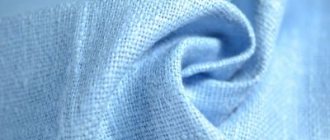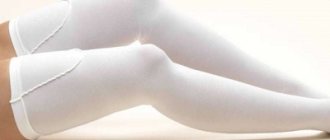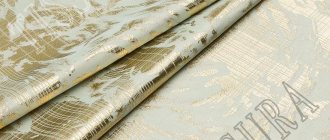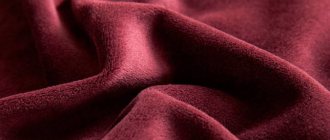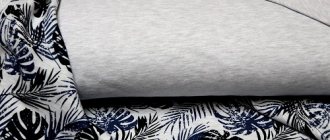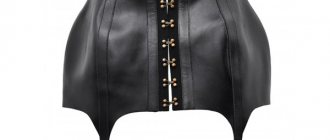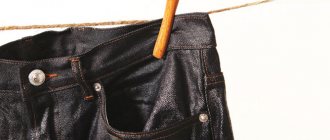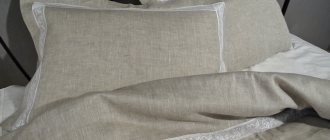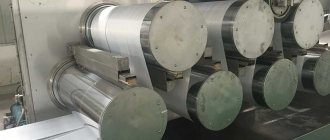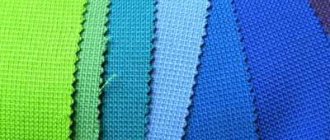At one time, linen clothing lost its relevance and was almost completely undeservedly forgotten. Today, when natural fabrics have returned to fashion, linen products have again become in demand. The range of linen clothing is huge; everything from nightgowns to men's suits is made from this fabric.
What is the reason for such popularity of linen fabric?
Linen is a fabric made from plant fibers. Its naturalness ensures complete hypoallergenicity. Clothing made of linen fabric not only does not cause allergies, but also does not irritate the skin if the skin already has a rash, inflammation, etc. Also, for allergy sufferers, linen bedding is recommended.
In addition, flax is a natural antiseptic. Interesting fact: bacteria and fungi are not able to multiply in linen fibers.
Another irreplaceable quality of flax, especially on hot summer days, is its ability to absorb excess moisture.
While things made from other types of fabrics have already stuck to the body and wet spots from sweat have appeared on them, linen absorbs excess moisture, and you feel great without being embarrassed that wet circles from sweat have appeared on your back or under your arms.
Clothing made of linen is highly breathable, providing excellent air exchange. Another feature of flax that is indispensable in the summer is that flax practically does not transmit ultraviolet rays through itself, only ten percent of the radiation reaches the skin.
Also, wearing a linen skirt or dress, you will not suffer from the unpleasant sensation of clothes “sticking” to your legs - linen fabric is antistatic.
Linen is a very durable and strong material. If stored properly, it can look great for decades.
Unfortunately, nothing is ideal in nature; although linen fabric has many advantages, it also has disadvantages. Linen is a highly wrinkled fabric, with the return of linen to fashion, it is not considered bad manners to walk around in slightly (and sometimes very) wrinkled things. Wrinkling in this case serves as evidence of the naturalness of the fabric, and therefore is not considered a significant drawback.
Linen does not like washing at high temperatures; it shrinks greatly, and the product can be irrevocably damaged. Also, linen fabric frays very much, the edges of the product must be carefully processed with an overlocker. When caring for linen products, these properties of the fabric must be taken into account.
So, where does caring for linen items begin, and what secrets do you need to know? When you buy a linen item in a store, be sure to read the manufacturer’s recommendations on the product tag. Very thin linen products, especially those with decorative elements, can only be dry cleaned. If the tag says “dry clean”, don’t tempt fate - don’t wash a good item, but take it to the dry cleaner.
Washing linen products is possible, depending on the type of fabric, at different temperatures.
- White linen clothes can be washed at temperatures up to ninety degrees.
- Multi-colored linen can withstand temperatures up to sixty degrees.
- Products made from plain-dyed linen can be washed at low temperatures, the maximum washing temperature should be forty degrees.
It is better to wash linen items by hand, but machine washing is also allowed. Since flax is subject to strong abrasion, it is better to avoid spinning.
The ability of flax to absorb water well during washing has negative consequences. Flax fibers, absorbing water, are saturated with laundry detergent. If additional rinsing is not applied, the powder may remain in the flax fibers and then destroy them from the inside. Since liquid laundry detergents rinse out much more effectively, opt for them. For hand washing, you can use regular laundry soap.
When washing by hand, table vinegar will help preserve the color of the product and get rid of the remnants of washing powder. Add a few tablespoons of vinegar to the rinse water. This technique will help remove powder from the fabric and make it much softer.
You can soften the fabric by soaking it for ten to twelve hours in a salt solution. For eight liters of water, five tablespoons of salt are enough.
Baking soda also has a softening effect. Dissolve half a glass of soda in water (eight to ten liters) and wash the linen product as usual.
Drying linen items
The sun's rays are a natural bleach for linen fabrics, so it is better to dry colored items in the shade. The hot sun will make the fabric stiff and difficult to iron. And since the tubular structure of the fibers absorbs foreign odors, the best place is fresh air or a well-ventilated room. To avoid the appearance of unnecessary folds, hang the clothes wet, slightly smoothed with your hands. A hanger will help maintain its shape, as the water will flow down and slightly stretch the product.
If possible, dry clothes horizontally, straightening them out. Linen dries instantly, so it doesn’t take much time. To speed up the process, clothes can be wrapped “snail-like” in a terry towel and left for 5 minutes. After this, just shake the item and send it to the ironing table.
Bleaching linen products
Oxygen bleach is ideal for bleaching linen items. It is added according to the dosage prescribed on the package. The product is soaked in this solution overnight and then placed in an automatic machine.
ARTICLE FOR YOU
How to wash things made of cambric: in the washing machine and by hand
Packaged persalt can also help if you soak flax in it along with a small amount of powder for no longer than 12 hours.
A weakly concentrated solution of acetic acid will also bleach a T-shirt or undershirt. It is necessary to soak the fabric in an enamel bath for 2-3 hours, covering with a lid. Then wash in any way.
Hydrogen peroxide is also a good whitener. Take 2 large spoons of the substance per liter of water. The product is soaked for 24 hours. The most harmless method for fabric is to use a powder with the “optical whitening” property.
Bleaching things
Washing linen to prevent it from shrinking
To prevent linen shrinkage, you need to study the quality of the purchased fabric. It’s good if the threads are woven evenly and the fibers are completely saturated with dye.
Truly high-quality flax, when properly heat treated, will never shrink. Because the responsible manufacturer first treated the fabric at boiling point before selling it.
If you have doubts about the quality of flax, then you need to adhere to the following recommendations:
- Choose the correct temperature mode (for white fabric no more than 60%, for colored fabric - no more than 40%). This way the fibers do not swell, which prevents them from coming into close contact;
- Iron the item when wet. Thus, squeezing the iron helps to forcefully stretch the fibers and fasten them in the desired shape.
It is also better to dry flax in a vertical position, so that its own gravity does not allow the linen to shrink.
Washing linen to help it shrink
When washed, any linen item will decrease in size if it contains at least 10% synthetic fibers. Therefore, you won’t have to do anything special for shrinkage.
Linen can shrink even if the product is manufactured by a low-quality manufacturer who did not heat-treat the fabric before selling it. It is impossible to achieve special shrinkage of 100% natural flax even when boiling it. The result will only be damage to the fabric pattern and its colors.
ARTICLE FOR YOU
How to properly wash neoprene items
If there are doubts about the quality of linen, it is enough to violate the temperature range during washing described above, and the linen will shrink. Also, to shorten it, you can dry the fabric horizontally and iron it only after it has completely dried.
Proper ironing of linen items
The main feature of linen is its textured folds, which, unlike other natural fabrics, look elegant and appropriate. Such items should be ironed carefully, avoiding creases and sudden movements. The iron is set at 200 °C with the steam boost function, and the laundry itself is moistened or ironed under-dried (not wet). The evaporating moisture will protect the delicate fabric from overheating.
To restore linen's natural shine, clothes should be ironed on the right side. And if the item shrinks a little after washing, iron it through a layer of thick fabric. Do not try to remove natural folds, they will still form, but they will look natural. Linen is allowed to be wrinkled - this is its special charm.
Machine or hand wash
The ideal option is hand washing. However, it is permissible to wash linen items in a washing machine. You should select a washing mode for delicate fabrics. It is very important that the product is not exposed to chlorine, which is often included in stain removers and bleaching powders. Contact with chlorine makes the fabric less durable, so you need to carefully study the composition of the detergent before use. If you don't want to waste time looking at the label, choose powder for washing children's clothes. Chlorine is rarely added to such powder.
For white linen items, oxygen bleach can be used. Items made from dyed or embroidered linen cannot be bleached.
How to store linen clothes?
Before storing linen items in the closet for storage until next season, be sure to iron them. It is recommended to place the laundry in vacuum packaging or wrap it in craft paper. Linen items should not be pressed or hung tightly together. Bulky clothes (jackets, trousers, suits) can be thrown directly onto the bar on hangers.
Be sure to take care of the absence of excessive heat and direct sunlight. Clothes should be taken out and aired from time to time, otherwise they will smell unpleasant. With proper care, with the onset of the summer season, linen items just need to be sprayed with water and ironed to remove any creases that have appeared. If your clothes are dry, put them in a bag and leave them in the freezer for a day. After this, ironing out old folds will become much easier. Interestingly, linen items only become easier to care for over time. The more often you wear your favorite linen shirt, the more often you wash it. And with proper care, the fibers of the fabric do not fade, they only become softer and more pleasant to the touch. Therefore, such practically “immortal” clothes are more expensive than cotton and other natural materials.
Preparatory activities
Before you begin the process of washing linen items, you need to choose the appropriate powder.
- For products made from this fabric, the best option would be a product that increases water alkalinity . Such an environment will facilitate the rapid destruction of dirt and will not harm the cellulose components that make up linen.
- For products made from linen fabrics, powders with reduced formation of soap suds are suitable. Products containing oxygen-based bleaches are often used.
- Caring for linen products requires soaking them before washing. If you don't have a washing machine with a soak function, you'll have to do it manually. It is necessary to pour clean water of medium temperature into a basin - up to 45 degrees, and place clothes there for half an hour. After this time, you should wring out the items and soak them again in another water. After 30 minutes you can start washing.
Variety of linen washing products
Manufacturers of linen products insist on a responsible approach to the choice of chemical detergents. It is better to give preference to liquid analogues. To wash colored items with embroidery, you need to use color-preserving compounds, which are marked accordingly on the packaging. Adding a teaspoon of vinegar to the water will also help preserve the color. You can also purchase powder with colored granules.
In addition to these products, various gels with o are used, which maintain the initial shape of the product, smooth, soften and protect the fabric. Such products do not contain whiteness, which is contraindicated for all linen products. Lion Acron is a good example.
Concentrated gels with a softener are also used. If you treat flax delicately, it also has a maximum cleaning effect. Easily removes stains on tablecloths without damaging the structure of the fabric. For example, Can Do is an economical gel to use due to its concentrated state; it dissolves well in water without leaving any sediment.
Lion Acron
Drying linen products according to the rules
To avoid creases and unsightly folds on linen, do not wring out or twist the washed item. It is enough to hang it on a hanger in a free state.
It is recommended to dry in conditions of good ventilation, without exposing the fabric to direct ultraviolet rays. Drying flax is prohibited near electric heating devices and on radiators.
If you plan to iron a linen shirt after heat treatment with water, then it is better to leave the item a little wet. If the fabric has dried completely, you can lightly wet it again.
ARTICLE FOR YOU
How to wash things from Loden: in the washing machine and by hand
Smoothing linen products
When ironing linen, it is better not to let it dry completely. Therefore, you can set the iron to “linen” mode and check the degree of drying during heat treatment. The product will look well ironed if you then hang it on hangers and let it dry on its own.
The softness of linen fabric during any type of washing is also affected by the condition of the water. It is often hard and the lime it contains accumulates in the fibers of the product. The tablecloth quickly fades, acquiring a gray tint. To soften the water, you can use half a glass of 3% vinegar or Calgon.
Detailed explanation of symbols on the label
Temperature is usually defined on labels using the standard designation t° Celsius. Some countries may use their own symbols, for example, things made in the USA or China are often marked with special symbols.
Wash
There are several different washing modes, we will tell you about the main ones.
The normal mode depends on the water temperature, and the gentle mode (soft) promotes delicate washing with a low risk of damaging items. When you turn on the very soft mode, things are processed several times more carefully, often even without the spin function. It is important to know that if the label prohibits spinning, then this means not only spinning during machine washing, but also by hand.
Machine washable and hand washable (all possible stages, even soaking and spinning).
Wash on gentle cycle (soft).
Delicate wash (softest setting).
Ban on washing
Machine washable, the degrees indicated are the optimal temperature.
Max t°= 95° - normal washing mode, boiling is allowed, most often this icon is on the labels of cotton and linen items that are resistant to boiling.
Max t°= 95° - soft mode.
Max t°= 70 - normal mode, suitable for cotton, linen, white or non-fading items made from colored fabrics.
Max t°= 60° - normal processing (cotton, polyester, fine fabrics).
Max t°= 60° - soft mode.
Max t°= 50° - normal processing.
Max t°= 50° - soft mode.
Max t°= 40° - normal processing, neutral detergents, this mode is suitable for colored and variegated fabrics made of cotton, viscose and synthetics.
Max t°= 40° - soft mode.
Max t°= 40° - very soft mode.
Max t°= 30° - normal processing, delicate detergents, cool water, suitable for wool and silk.
Max t°= 30° - soft mode.
Max t°= 30° - very soft mode.
Wash exclusively by hand in warm water, do not use force or spin. Maximum temperature = 30° - 40°.
Whitening
Bleaching with oxidizing agents is allowed.
Only bleaching with oxygen-containing and non-chlorine reagents is allowed.
Bleaching is prohibited.
Drying and spinning
Drying and spinning are allowed.
Drying and spinning in an electric dryer and washing machine are allowed.
Drying and spinning are prohibited (this icon is used in conjunction with the “washing prohibited” icon).
Drum drying
Soft drying mode, medium temperature.
Max t°= 60° - soft mode.
Max t° = 60° - very soft mode.
Drying and mode at normal temperature.
Do not tumble dry.
Natural drying
Dry washed and wrung out items on a line or hanger.
Dry washed and unwrung items on a line or hanger.
Dry washed and wrung out items on a flat surface.
Natural drying in the shade
Dry washed and wrung out items in the shade on a line or hanger.
Dry washed and unwrung items in the shade on a line or hanger.
Dry washed and wrung out items in the shade and lay them out flat.
Twisting
The product can be squeezed out manually by twisting the item.
Twisting and manual squeezing are prohibited!
Ironing and steaming
Max t° of the iron sole = 200°, can be steamed.
Max t° of the iron sole = 150°.
Max t° of the iron sole = 110° without steaming.
Ironing is prohibited.
Steaming is prohibited.
Professional care/cleaning (dry cleaning)
Dry cleaning (dry cleaning).
Dry cleaning is prohibited.
Dry cleaning with organic solvents is permitted.
Wool
The most common natural fiber, obtained from animal hair. Properties: hygroscopic, retains heat well, elastic, wrinkle resistant. Wash in warm water (30 degrees), rinse in colder water; bleach only using perborates; do not wring out, wrap the product in a towel to absorb excess moisture; things must be dried by laying them out on a dry and flat surface; place in the shade, away from heat sources; iron with a low-heat iron, using a damp piece of cloth between the iron and the woolen item; store in an airtight container with special protection (naphthalene, camphor).
Silk
The only natural fiber obtained from insects. Silk has been considered synonymous with luxury since ancient times. Properties: breathable, lightweight, durable, elastic, shiny. Dry cleaning is preferred; when washing at home, use water no more than 30 degrees and neutral soap; rinse well in cool water, squeeze very carefully and delicately; iron at very low temperature.
Cotton
The most common natural fabric in the world, it is made from plant seeds. Properties: good breathability, lightness, heat resistance, strength.
colored cotton items can be washed in a washing machine, but the maximum washing temperature should not exceed 30 degrees; It is better to bleach only white products; before ironing, the item must be slightly moistened; iron at very high temperature.
Linen
The oldest fabric in the world and one of the most expensive, as flax fiber is extracted from the skin of the plant stem. Properties: breathability, softness, strength. Before washing, the product can be soaked to remove greasy stains; use sodium perborates for bleaching; can be washed in a washing machine, but without spinning; iron at high temperature, after moistening the product.
Viscose
A fiber obtained from cellulose. Properties: has a pleasant silky shine, pleasant to the touch, absorbs moisture well, durable. If you can wash by hand, use cold water; Dry on hangers (except for special instructions on the label), gentle twisting when squeezing is recommended. Knitwear should be dried by laying it out on a flat surface; iron at medium temperature.
Modal
A product of a type of viscose fabric. Properties: soft and very pleasant to wear fabric. carefully read the product care instructions, as some products can be washed by hand in warm water without wringing, and some require dry cleaning only, as they lose their structure if they are wet; iron at moderate temperature.
Acetate
An artificial fabric made from cellulose. Properties: soft, delicate fabric with a pleasant silky shine. wash in warm water using a neutral detergent; use dry cleaning if indicated on the label; iron the inside of the product at low temperature; It is recommended to dry on a flat surface, without curling.
Polyester
Synthetic fiber. Properties: elasticity, elasticity, tensile strength. machine or hand wash in warm water; It is recommended to iron at medium temperature, using a damp piece of cloth between the iron and the item, in order to avoid the characteristic shine after ironing.
Nylon
The first synthetic fiber. Properties: high strength. wash in a washing machine or by hand at low temperature; dry without squeezing.
Acrylic
Synthetic fabric. Properties: light, soft, voluminous, warm. machine wash in warm water; more delicate items should be washed by hand; Lightly squeeze out the remaining water and hang the product almost dry. Knitwear should be dried by laying it out on a flat surface; Ironing is recommended at medium-low temperature.
“...or give it to your mom.
She knows how to do it . (Inscription on the label).
Sewing workers and printers who print labels for clothes will, of course, smile, but many “ordinary citizens” do not know that the squares of fabric often included with clothes are not intended for making patches at all, but for testing the susceptibility of the product to various types of care - washing , ironing, dry cleaning.
To make it easier for consumers to choose care regimens for clothing and other garments, they are provided with a fabric tag (label) that contains specific recommendations for choosing all types of operations.
Compliance with the rules of product processing is extremely important for the correct operation of the product, which, in turn, can significantly extend its life and avoid premature damage.
Care badges are printed on so-called “sewn-in fabric labels”, fixed in the seams of the product from the wrong side. Labels are made from materials that correspond to the fabric used in sewing clothes: cotton, nylon, polyester, etc.
Symbols for the care of clothing, linen, hats and other textile products are divided into five groups:
The clothing care icon system is built on several basic and additional symbols that are not difficult to remember.
Dry cleaning
Normal dry cleaningDry cleaning with any organic solvent |
Dry cleaning only with special reagentsNormal dry clean using tetrachlorethylene and all solvents listed for symbol "F" |
Delicate dry cleaning with special reagentsDelicate dry cleaning with limited addition of water with careful use of solvents indicated for the “P” symbol, as well as control of mechanical stress and drying temperature, self-cleaning is prohibited |
Dry cleaning with hydrocarbon solvents onlyConventional dry cleaning using only hydrocarbon, gasoline and TFC |
Delicate dry cleaning with hydrocarbon solvents onlyDelicate dry cleaning with limited addition of water with careful use of solvents indicated for the “F” symbol, as well as control of mechanical stress and drying temperature, self-cleaning is prohibited |
Regular wet professional cleaning (aqua-cleaning)Normal wet cleaning and drying according to IEC 456 |
Delicate wet professional cleaningDelicate water cleaning mode with restrictions on the mechanical mode and drying mode, taking into account the characteristics of the product, relative shrinkage - 50+5% |
Particularly gentle wet professional cleaningVery delicate water cleaning mode with restrictions on the mechanical mode and drying mode, taking into account the characteristics of the product, relative shrinkage - 25+2.5% |
Shortened dry cleaning cycleClothes can be cleaned in a shortened cycle. The symbol can be used in combination with a letter |
How to wash by hand correctly?
Washing jackets, pants, curtains, skirts and dresses by hand takes a lot of effort, but if the item is dear to you - for example, a handmade dress, it is better to spend more effort and time than to risk sending it to the washing machine. Take a larger basin and dissolve a little detergent in water. Wash items thoroughly and rinse them by hand. When washing colored items, regardless of their size, it is advisable to add a teaspoon of acetic or citric acid to the rinse water.
